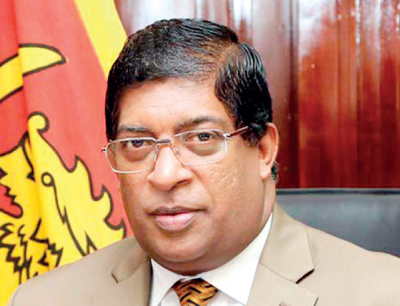Thursday Apr 03, 2025
Thursday Apr 03, 2025
Thursday, 16 June 2016 00:00 - - {{hitsCtrl.values.hits}}
 In a TV appearance by the Minister of Finance Ravi Karunanayake (Face the Nation Program TV1 Sirasa TV, on 13 June), the subject of the CBSL T. Bond issue came up for discussion. The FM expressed several concerns in defending Central Bank Governor Arjuna Mahendran and inter-alia, asked if anybody had calculated any loss arising out of this allegation. In fact, he categorically asked: “What was the loss to the Government as a result of the bond deal of February 2015?”
In a TV appearance by the Minister of Finance Ravi Karunanayake (Face the Nation Program TV1 Sirasa TV, on 13 June), the subject of the CBSL T. Bond issue came up for discussion. The FM expressed several concerns in defending Central Bank Governor Arjuna Mahendran and inter-alia, asked if anybody had calculated any loss arising out of this allegation. In fact, he categorically asked: “What was the loss to the Government as a result of the bond deal of February 2015?”
By now, all concerned are aware of the calculated loss not only to the Government but even to some of the primary dealers as consequential losses on their operations because the matter has been discussed widely in different forums publicly. However, it appears that either the Minister has not been presented with true facts or has been misinformed.
As the Minister of Finance he was the biggest loser, resultantly extending the same to the people of this country vis-à-vis the huge unprecedented gain of one primary dealer, which in this instance happens to be a company having a direct relationship with Mahendran.
In the context, it will be appropriate to revisit the issue and examine the statistical data to clarify matters.
The 30-year bond carrying a fixed interest rate of 12.5% was advertised by the CB for a value of Rs.1 billion (12.50%-2045A) for the  Auction to be held on 27 February 2015. As a practice, with every such advertisement, the Public Debt Department (PDD) of CBSL used to indicate a rate to the primary dealers to submit their bids. This rate is based on the prevailing market rates for similar bonds and this was intended to dissuade primary dealers from bidding at rates pretty much above or far below the prevailing rates. In this manner the Public Debt Department attempts to keep the auction rates as close as possible to the going market rates or, in other words, the prevailing yield curve.
Auction to be held on 27 February 2015. As a practice, with every such advertisement, the Public Debt Department (PDD) of CBSL used to indicate a rate to the primary dealers to submit their bids. This rate is based on the prevailing market rates for similar bonds and this was intended to dissuade primary dealers from bidding at rates pretty much above or far below the prevailing rates. In this manner the Public Debt Department attempts to keep the auction rates as close as possible to the going market rates or, in other words, the prevailing yield curve.
The indicative rate communicated to the primary dealers by CBSL on this impugned bond deal was 9.5%, which in effect means that the primary dealers have to submit their bids at a price of around Rs. 131 per Rs. 100 bond. At this price, the Minister of Finance would have got a premium income of Rs. 31 for every Rs. 100 bond under this bond issue.
In this instance, the indicative rate given by the Public Debt Department has been on the high side since it was based on a 30-year bond carrying an interest rate of 13.5%. When the price is adjusted for the 12.5% rate, which the bond in question was expected to carry, the price comes to about Rs. 121 for every Rs. 100 bond. Even at this price the Minister would still have got a premium income of Rs. 21 since the market was willing to buy bonds around that price.
In fact, according to the bid details publicised pertaining to this bond issue by the three lawyers’ committee appointed by the Prime Minister, almost all the primary dealers had submitted bids around that price. The Bank of Ceylon (BOC) itself had submitted a bid on behalf of their customers at 9.5% i.e. at a price of Rs. 121.
However, strangely, the same BOC submitted bids after getting an extension of the closing time of the bid (during the last 30 minutes before the closure of the tender) at prices ranging between Rs. 87 and Rs. 97 on behalf of another primary dealer (the one in the centre of this fiasco), Perpetual Treasuries.
When the Chief Dealer of BOC was questioned by the three lawyers’ committee about this strange pricing of the bids, his answer was, according to the report, that the CEO of Perpetual Treasuries told him in Sinhala “Awoth atha thamai,” meaning tremendous profits if successful.
As all these bids were over and above the amounts declared in the auction, this primary dealer was aware in no uncertain terms that the Government would go for more than Rs. 1 billion, the announced figure, and this information appears to be exclusively available to this primary dealer company. This fact is more than evident when the bid amounts of all other primary dealers are examined.
The Public Debt Department decided to go for Rs. 10 billion at the end of the auction due to the insistence of Mahendran, according to reports. As a result, Perpetual Treasuries was the all-successful bidder in getting 50% of that amount at the highest price compared to others. Even the three lawyers’ committee which was strangled with limited terms of reference has remarked in its report that this was an unusual thing warranting a full investigation.
This bond which would have been sold in the market for Rs. 121 was sold around Rs. 91 to this primary dealer, causing losses amounting to Rs. 1.b Billion immediately to Minister Ravi Karunanayake. Further, the decline in the market interest rates caused heavy losses to other primary dealers and investors due to their having to capture the loss by marking their portfolios by way of adjustment to the new lower market rates.
The biggest loser was the National Savings Bank, another State-owned institution (however not coming under the Finance Minister due to the State banks being taken out from his domain)!
With such information in the background, perhaps the Minister of Finance could come up with more plausible explanations and clarifications as a responsible Finance Minister, setting aside his political affiliations.
Discover Kapruka, the leading online shopping platform in Sri Lanka, where you can conveniently send Gifts and Flowers to your loved ones for any event including Valentine ’s Day. Explore a wide range of popular Shopping Categories on Kapruka, including Toys, Groceries, Electronics, Birthday Cakes, Fruits, Chocolates, Flower Bouquets, Clothing, Watches, Lingerie, Gift Sets and Jewellery. Also if you’re interested in selling with Kapruka, Partner Central by Kapruka is the best solution to start with. Moreover, through Kapruka Global Shop, you can also enjoy the convenience of purchasing products from renowned platforms like Amazon and eBay and have them delivered to Sri Lanka.
Discover Kapruka, the leading online shopping platform in Sri Lanka, where you can conveniently send Gifts and Flowers to your loved ones for any event including Valentine ’s Day. Explore a wide range of popular Shopping Categories on Kapruka, including Toys, Groceries, Electronics, Birthday Cakes, Fruits, Chocolates, Flower Bouquets, Clothing, Watches, Lingerie, Gift Sets and Jewellery. Also if you’re interested in selling with Kapruka, Partner Central by Kapruka is the best solution to start with. Moreover, through Kapruka Global Shop, you can also enjoy the convenience of purchasing products from renowned platforms like Amazon and eBay and have them delivered to Sri Lanka.